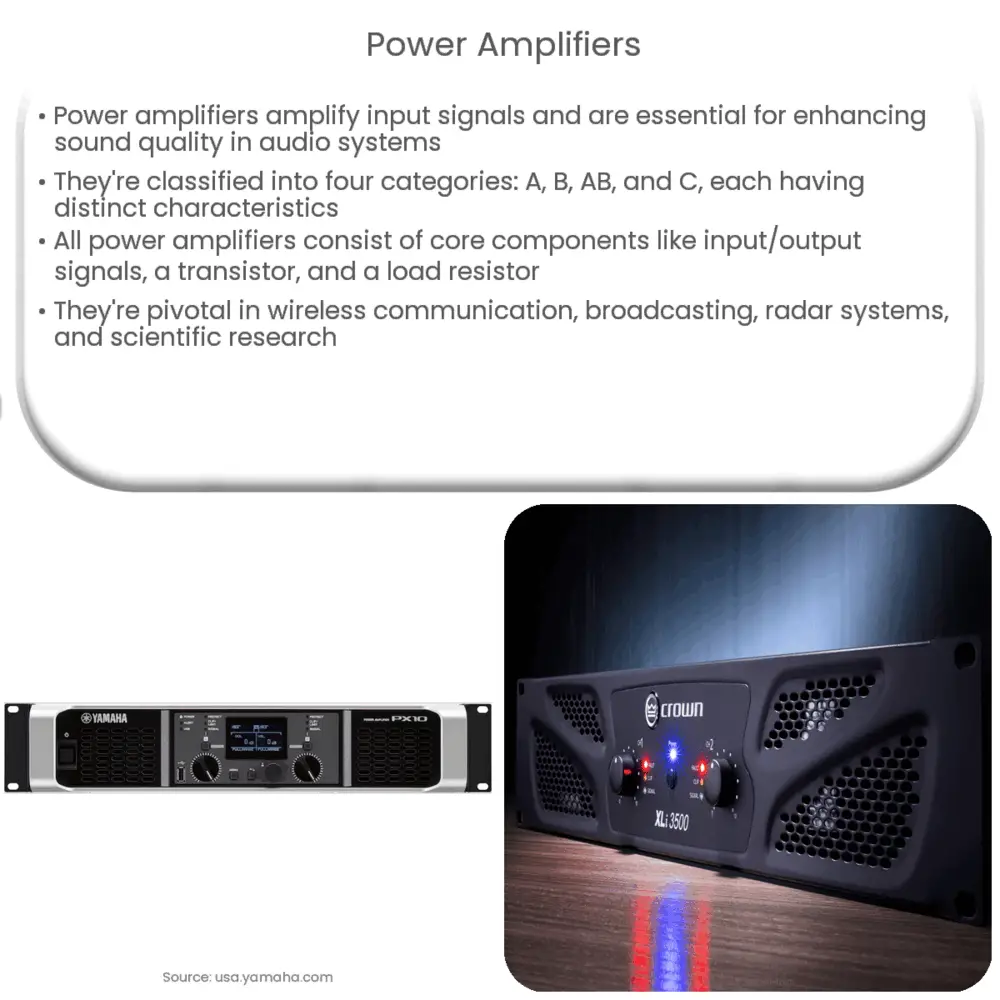Explore the world of power amplifiers: their types, key components, working, and diverse applications in audio systems, wireless communication, and more.

Introduction to Power Amplifiers
Power amplifiers, as the name suggests, are electronic devices designed to amplify the power of an input signal. Predominantly utilized in audio equipment, they play a vital role in enhancing sound quality. However, their application isn’t limited to audio systems alone, and they find relevance in various fields, including wireless communication and broadcasting.
Categories of Power Amplifiers
Power amplifiers are broadly classified into four categories: A, B, AB, and C, each with unique characteristics and applications.
- Class A: They are known for their excellent linearity and minimal signal distortion, but at the cost of low efficiency. They are often used in high-fidelity sound systems.
- Class B: More efficient than Class A, Class B amplifiers tend to distort signals at crossover points. They are frequently used in audio applications where power efficiency matters more than audio quality.
- Class AB: This class represents a middle ground between Classes A and B, offering a balance between signal quality and power efficiency. They are extensively used in car audio systems.
- Class C: With the highest power efficiency, Class C amplifiers are usually used in radio frequency transmission where the distortion doesn’t significantly impact the performance.
Key Components and Working
Despite the differences in classes, all power amplifiers share a common set of core components: input and output signals, a transistor, and a load resistor. The transistor acts as a key switch, controlling the amount of current flowing through the circuit, which in turn influences the output signal’s amplitude.
The basic operation involves the input signal modulating the transistor’s base current. This current control then influences the transistor’s collector current. A direct relationship exists here – a small change in the base current leads to a large change in the collector current, resulting in an amplified output signal.
Applications of Power Amplifiers
Power amplifiers serve a multitude of applications. As mentioned earlier, their primary use lies in audio systems such as public address systems, home theatre systems, and professional concert sound systems. In the realm of wireless communication, they play a vital role in enhancing the signal strength for transmission. Other applications include broadcasting systems, radar systems, and even in scientific research for signal processing and conditioning.
The Role of Power Amplifiers in Wireless Communication
Power amplifiers have an indispensable role in wireless communication. They amplify the signals generated by transmitters, ensuring they are strong enough to travel long distances. They work in tandem with antennas to broadcast signals over large areas, thus enabling seamless communication between devices. Without power amplifiers, our phones, radios, and televisions wouldn’t receive signals strong enough to ensure reliable communication.
Power Amplifiers in Broadcasting and Radar Systems
In broadcasting systems, power amplifiers are used to boost signals to a level suitable for transmission. They allow radio and television stations to broadcast signals that reach receivers far and wide. Similarly, in radar systems, power amplifiers enhance the strength of the signals sent out by the radar. The stronger the signal, the further it can travel and the more information it can gather, improving the system’s overall performance.
Scientific Applications
In scientific research, power amplifiers are employed in various signal processing and conditioning tasks. They are used to amplify signals from sensors and transducers, making them strong enough to be recorded and analyzed. Moreover, power amplifiers are also used in experimental setups that require high power levels, such as particle accelerators and plasma research.
Conclusion
In conclusion, power amplifiers are integral components in a wide array of devices and systems. They play a crucial role in enhancing the strength of input signals, whether in an audio system, a broadcasting station, or a scientific research setup. The various classes of power amplifiers, each with its unique characteristics and applications, offer an array of options for different scenarios. The choice depends on the balance between the desired audio quality and power efficiency. As technology evolves, power amplifiers continue to improve, leading to more efficient and reliable systems that shape our world in numerous ways.

